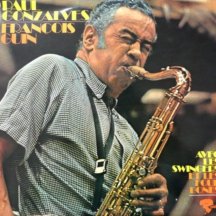 Encuentro Catalyst CAT-7913 1977 LP & TROVA TL-22 1989 LP Recorded 15th September 1968 - Argentina |
Personnel
Paul Gonsalves - Tenor Saxophone Gerard Badinio - Tenor Saxophone Norris Turney - Alto Saxophone / Flute Xavier Chambon - Trumpet Pierre Dufour - Trumpet / Bugle Daniel Bruley, Michel Camicas, Luis Fuentes, Claude Gousset & Francois "Frick" Guin - Trombone Chuck Connors - Bass Trombone Gerard Gambus - Piano Riccardo Galeazzi - Bass Teddy Martin - Drums |
Track Listing
1. Darn that Dream (Delange & Van Heusen) 2. Blue Revival (Badini) 3. The World is Sad and Blue (Badini) 4. Mademoiselle de Paris (Durand & Contet) 5. Jumping at the Woodside (Basie) 6. Taverns Tune (Guin) 7. Ending Blues (Dutour) |
Duke Ellington and his prestigious soloists, among them Paul Gonsalves, participated in the festival of Paris at the Salle Pleyel. A few weeks later they gave a concert of sacred music in church St. Sulpice, where the intensity and fervor thrilled the enthusiastic audience, except for two or three common retrograde spirits. Finally, they had a crazy night in Alcézar where all of Paris wore tuxedos and evening gowns to celebrate the seventy years of the most famous American composer.
On the other hand, the Swingers had a tireless period of activity as well. Summer had seen success in the Festival of Antibes-Juan-les-Pins, and Paris was to give them deserved recognition; therefore, they would play in the Festival of Paris, after a first live show for ORTF from the José Artur club. Francois Guin became part a few days after Ellington's orchestra for the concert at Pleyel and had the pleasant surprise of sharing “C Jam Blues” with Archie Shepp, invited at the last minute. The Swingers were to also take part in the Festivals of Alcézar, presenting, in collaboration with Claude Bolling, a tribute to Duke Ellington, after which Ellington wanted to get on stage with Francois Guin, failing to overcome the resistance of principal swingers.
This album is, so to speak, the testimony of the exciting days we have had occasion to live in during the fall of 1969. A long time ago I wanted to organize a recording with Paul Gonsalves, because of all the great contemporary saxophonists, he is undoubtedly the best suited to all environments, but possesses a remarkable personal style. The versatility that he displys each time the opportunity is presented, you tuely observe the apparent contradictory aspects of his personality. On a fast tempo, his phrasing seems tormented; beautiful sonority, but showing a weakness and torrential inspiration. In the ballads, however, displays a delicate lyricism, reinforced by a sensual sound.
Paul Gonsalves is not only an eminent musician but a good friend, and in this respect prefers to play in a friendly environment. In principle, it seemed preferable to preparing one of those recording sessions out of the blue, causing the improvisation of soloists. As the Swingers and Four Bones had planned recording an LP, and among good friends Gonsalves were, as Gerard Badini, it was decided to join forces with each other to get the album you have in your hand. Francois Guin wrote the arrangements, and after a phone call to Bologne, which was at that time where the Ellington orchestra were, Chuck Connors and Norris Turney joined us, the first to occupy the post of bass trombone, and the second to play flute adding some variation, and high notes in Jumping at the Woodside. Finally, rang the H hour, the morning of 17 November, shortly after the concert of St. Sulpice, and we knew we could not waste time, for that same morning a plane was to take Paul Gonsalves towards a new stage ...
Twenty years ago Paul Gonsalves wanted to record “Darn That Dream”, and this long wait partly explains how it has become a masterpiece. His interpretation of this subject is placed among the most beautiful ballads for tenor saxophone, next to the most famous of Coleman Hawkins, Lester Young, Don Byas, Ben Webster and John Coltrane. Besides Gonsalves, whose sensitivity has never been so evident, Gerard Badini plays a second magnificent tenor solo. Halfway through the piece a trio of trombones deserve the appreciation of connoisseurs. The “World is Sad and Blue” is another ballad, down to the inspiration of Badini, in the same lines as the previous one. The soloists are also Paul Gonsalves and Gerard Badini.
To satisfy a desire of Gonsalves, who wanted to interpret a French song, Francois Guin prepared an arrangement of “Mademoiselle de Paris”, allowing the tenor of Ellington's musician to variations full of fantasy, after a flute solo of Norris Turney. In return, the French musicians proposed “Jumping at the Woodside”, the classic of Count Basie. It is simultaneously a battle of saxophones and a family photo since fourteen musicians contributed something.
The usual repertoire of the Swingers comprises the remaining three titles: “Blue Revival”, “Tavern's Tune” and “Ending Blues”. Upon exit of the session we expected a gray day; the musicians were exhausted, but his eyes shone a fleeting light close to bliss. Jazz had just experienced a new party in Paris.
Alexandre Rado
Translated from the original French liner notes.

Made in RapidWeaver